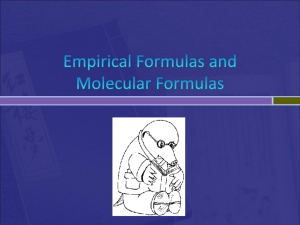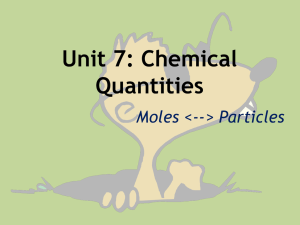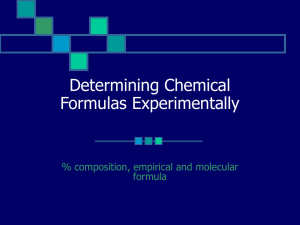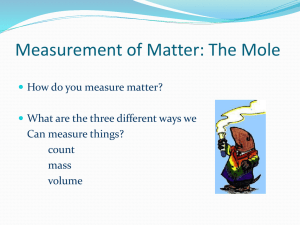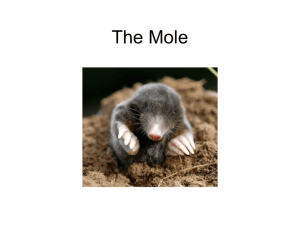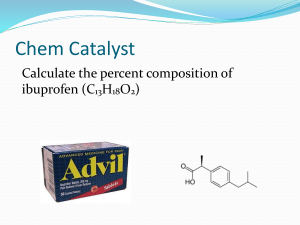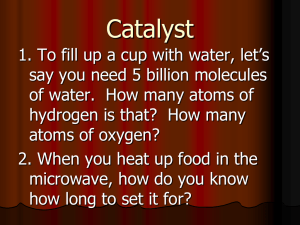Example - Course
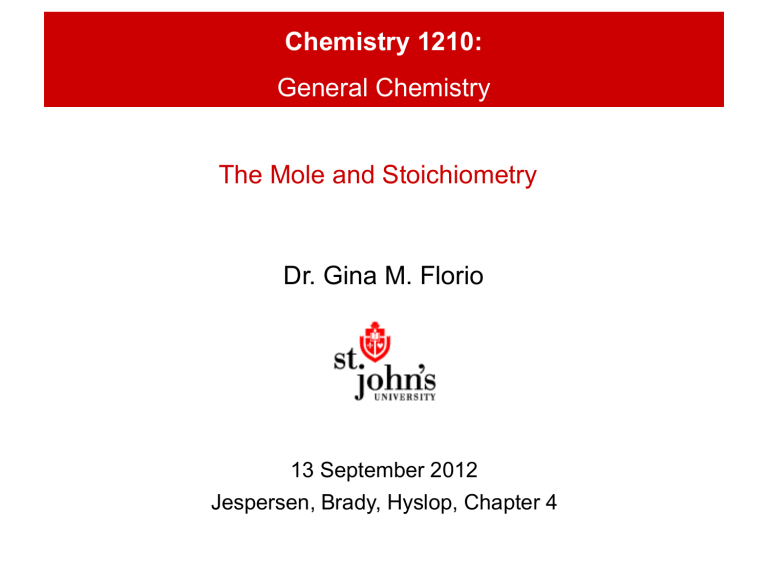
Chemistry 1210:
General Chemistry
The Mole and Stoichiometry
Dr. Gina M. Florio
13 September 2012
Jespersen, Brady, Hyslop, Chapter 4
Conversion Factors
Conversion Factor
– relates one quantity to another
– used to convert between two units in chemistry
What is my height in centimeters (cm) if I am 5 feet 4 inches tall?
1. How many inches are in a foot?
12 inches = 1 foot
2. How many inches are in a centimeter?
1 inch = 2.54 cm
Factor Label Method
The factor-label method , or dimensional analysis lets us treat a numerical problem as one involving a conversion from one kind of units to another using conversion factors .
Example:
A recipe calls for 32 grams of cheese. My kitchen scale only displays weight in ounces. How many ounces of cheese do I need to use?
Conversion
Factor
1 ounce = 28.349 523 125 grams
Factor Label
Method
32
grams
1
28
ounce grams
1.3
ounces
Atomic Mass and Molecular Mass
Atomic Mass – the mass of an individual atom measured in atomic mass units, u
– listed in the periodic table beneath the element symbol
Molecular Mass – the mass of an individual molecule measured in u
– the sum of the atomic masses of the atoms in the molecular formula
Example:
The molecular mass of water, H
2
O, is twice the mass of hydrogen (2 x 1.008 u) plus the mass of oxygen (15.999 u)
= 18.015 u
Ch 4.1
Formula Mass
Formula Mass – the mass of an individual formula unit measured in atomic mass units, u
– used for ionic compounds
– calculated the same as a molecular mass
Example:
The formula mass of calcium oxide, CaO, is the mass of calcium (40.08 u) plus the mass of oxygen (15.999 u)
= 56.08 u
Ch 4.1
The Mole: Connecting the macroscopic & molecular
The mole is a conversion factor
– relates mass to the number of atoms or molecules for a chemical substance (element, molecular compound, ionic compound)
– one mole of a substance has a mass (g) equal to its formula (or molecular or atomic) mass (u)
Example H
2
O
Molecular Mass = 2(H) + (O)
= 2(1.0 g) + 16.0 g
= 18.0 g
1 mole H
2
O = 18.0 g H
2
O
Ch 4.1
How many water molecules are in a mole of water?
1 mole H
2
O = 18.0 g H
2
O
Recall:
1 molecule H
2
O = 18.0 u (molecular mass)
Need the conversion factor between mass (g) and u:
1 u = 1.66 x 10 -27 kg
Need the conversion factor between g and kg:
1 kg = 1000 g
Answer:
Ch 4.1
Avogadro, how many ______ are in a mole?
6.023 x 10
23
______ are in a mole.
Always.
The “blank” can be anything:
Flowers
Cats
Grains of sand
Molecules
Ch 4.1
This conversion factor (6.023 x 10 23 objects/mole) is known as Avogadro's number .
Avogadro’s Number
Two important points:
1. Notice the magnitude of Avogadro's number (6.023 x 10 23 ):
~10
23
Why is this number so
HUGE
?
Because atoms and molecules are so tiny
.
A huge number of atoms or molecules are needed to make a lab-sized sample.
2. Avogadro’s number links moles and atoms , or moles and molecules , and provides an easy way to link mass and atoms or molecules .
Ch 4.1
Example Problem
Assuming that pennies are 100% Cu, how many Cu atoms are found in a penny weighing 3.00 g?
1. Convert mass (g) to moles using molar mass
2. Convert moles to number of atoms (or molecules) using Avogadro’s number
Ch 4.1
Mole-to-Mole Ratios: Chemical Formulas
Recall:
Water (molar mass 18.015 g/mol) as an example:
1 mole H
2
O 6.023 x 10 23 molecules H
2
O
1 mole H
2
O 18.015 g H
2
O
18.015 g H
2
O 6.023 x 10 23 molecules H
2
O
Mole-to-Mole Ratio:
Within chemical compounds, moles of atoms always combine in the same ratio as the individual atoms themselves.
1 mole H
2
O 2 moles H
1 mole H
2
O 1 mole O
Ch 4.2
Stoichiometry
Stoichiometry – the study of the mass relationships in chemical compounds and reactions
– relates the masses of reactants needed to make a compound
– MOLE to MOLE ratios
Ch 4.2
Ch 4.2
Example Problem
How many grams of iron are in a 15.0 g sample of iron(III) oxide?
ANALYSIS: 15.0 g Fe
2
O
3
? g Fe
KNOWN: 1 mol Fe
2
O
3
2 mol Fe
1 mol Fe
2
O
3
159.7 g Fe2O3
1 mol Fe 55.85 g Fe
SOLUTION:
Percent Composition
Percentage composition (or percentage composition by mass )
The percentage by mass is the number of grams of the element in
100 g of the compound and can be calculated using:
% element
mass of element mass of whole sample
100
%
From our previous example:
% Fe
10 .
5
15 .
0 g g Fe
Fe
2
O
3
100 %
70 .
0 % Fe by mass
Ch 4.2
Percent Composition, Why Should I Care?
Hmmm…what in the world is this stuff?
Detective, send that sample back to the lab for analysis!
Sample Problem
A sample was analyzed and found to contain 0.1417 g nitrogen and
0.4045 g oxygen. What is the percentage composition of this compound?
ANALYSIS: Find sample mass and calculate %
KNOWN: Mass of the whole sample
Whole Sample
0 .
1417 g N
0 .
5426 g
0 .
4045 g O
SOLUTION:
Ch 4.2
Molecular Formula & Empirical Formula
Hydrogen peroxide consists of molecules with the formula H
2
O
2
.
This is called the molecular formula .
However, the simplest formula for hydrogen peroxide is HO and is called the empirical formula .
The empirical formula thus contains the simplest mole-to-mole ratio of the atoms in the compound.
We can calculate the empirical formula for a compound from mass data.
Ch 4.3
Example Problem
A 2.012 g sample of a compound contains 0.522 g of nitrogen and 1.490 g of oxygen. Calculate its empirical formula.
ANALYSIS: We need the simplest whole number mole ratio between nitrogen and oxygen
SOLUTION:
Convert to moles
0 .
522 g N
1 mol N
14.01
g N
0.0373
mol N
1 .490
g O
1 mol O
15.999
g O
0.0931
mol O
Find the simplest
N whole number
0.0373
O
0.0373
0.0931
N
1.00
O
0.0373
2.50
mole-to-mole ratio
N
1.00
2
O
2.50
2
N
2.00
O
5.00
N
2
O
5
Ch 4.3
Empirical Formula (a few final notes)
The formula for an ionic compound is the same as the empirical formula .
For molecules, the molecular formula and empirical formula are usually different.
The molecular formula will be a common multiplier times all the coefficients in the empirical formula.
Example:
The empirical formula of hydrazine is NH
2
, and its molecular mass is 32.0 g/mol. What is its molecular formula?
Ch 4.3
Indirect Analysis of Empirical Formula
Combustion Analysis: an indirect method used to determine the empirical formula of a unknown compound containing only C, H, and O.
When a compound made only from C, H, and O burns completely in pure oxygen (O
2
) only carbon dioxide (CO
2
) and water (H
2
O) are produced:
___ C x
H y
O z
___ O
2
( g )
___ CO
2
( g )
___ H
2
O
We can collect and quantify all of the carbon dioxide (CO
2
) and water (H
2
O) produced to find the empirical formula of the original compound.
Ch 4.3
Example Problem
The combustion of a 5.217 g sample of a compound of C, H, and O gave
7.406 g CO
2 and 4.512 g of H
2
O. Calculate the empirical formula of the compound.
ANALYSIS: This is a multi-step problem.
First determine the mass of each element.
Then use the masses of the elements to calculate the empirical formula of the compound.
Ch 4.3
Example Problem
The combustion of a 5.217 g sample of a compound of C, H, and O gave
7.406 g CO compound.
2 and 4.512 g of H
2
O. Calculate the empirical formula of the
SOLUTION:
Ch 4.3
Stoichiometry & Chemical Equations
The coefficients of a balanced chemical equation provide the mole-to-mole ratios for the substances involved in the reaction.
Whenever a problem asks you to convert between different substances, the calculation usually involves a mole-to-mole relationship.
Example:
If 0.575 mole of CO
2 is produced by the combustion of propane, C
3
H
8 how many moles of oxygen are consumed? The balanced equation is:
,
C
3
H
8
+ 5 O
2
3 CO
2
+ 4 H
2
O
Ch 4.4
Balancing Chemical Equations
Chemical equations provide quantitative descriptions of chemical reactions.
Conservation of mass is the basis for balancing equations.
To balance an equation:
1. Write the unbalanced equation.
2. Adjust the coefficients to get equal numbers of each kind of atom on both sides of the arrow
Ch 4.4
Balancing Chemical Equations: some tips
Guidelines for Balancing Equations:
1. Balance elements other than H and O first
2. Balance as a group any polyatomic ions that appears unchanged on both sides of the arrow
3. Balance separately those elements that appear somewhere by themselves
4. As a general rule, use the smallest whole-number coefficients when writing balanced chemical equations
Example:
_ NH
3
+ _ O
2
_ NO + _ H
2
O
Element Reactants Products
N
O
H
Ch 4.4
_ NH
3
+ _ O
2
_ NO + _ H
2
O
Element Reactants Products
N
O
H
Limiting Reactants (aka Limiting Reagent)
All reactions eventually use up a reactant and stop.
The reactant that is consumed first is called the limiting reagent (reactant) because it limits the amount of product that can form.
Any reagent that is not completely consumed during the reactions is said to be in excess .
The computed amount of product is always based on the limiting reagent.
Ch 4.5
Example Problem
Example:
How many grams of NO can form when 30.0 g NH
3 according to: and 40.0 g O
2 react
4 NH
3
+ 5 O
2
4 NO + 6 H
2
O
Ch 4.5
Percentage Yield
The amount of product isolated from a chemical reactions is almost always less than the calculated, or maximum, amount.
The actual yield is the amount of the desired product isolated.
The theoretical yield is the amount that would be recovered if no loss occurred (the calculated, maximum amount).
The percentage yield is the actual yield as a percentage of the theoretical yield:
percentage yield
actual yield theoretica l yield
100 %
Ch 4.6


